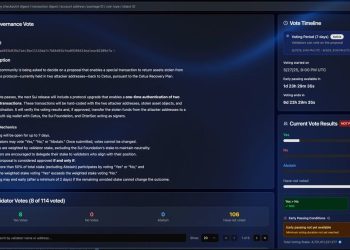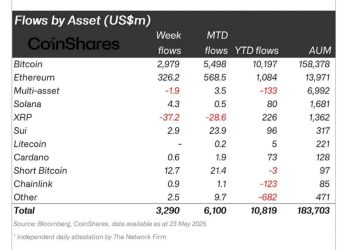TVL across Ethereum restaking protocols has dropped 37% from its December 2024 peak.
Liquid restaking protocols are on the decline amid slowing user demand and slashed incentives – with the exception of Ether.fi.
The total value locked (TVL) across liquid restaking protocols has dropped around 37% from its peak in December 2024 – falling from over $18.3 billion to $12 billion, according to DeFiLlama data. This figure currently places liquid restaking as the seventh-largest protocol category by TVL.
Meanwhile, EigenLayer – a middleware protocol that allows users to restake their ETH to provide shared security to other applications – currently boasts a TVL of 4.4 million ETH, down one million ETH from its June 2024 peak of 5.4 million ETH. Liquid restaking protocols enable users to participate in the EigenLayer ecosystem while retaining access to their liquidity in the form of liquid restaking tokens (LRTs).
Kelp, the second-largest liquid restaking protocol by TVL, currently holds around 557,000 ETH, a 10% drop from its April peak of approximately 615,000 ETH. In contrast, Renzo, the third-largest by TVL, has recorded a far sharper decline, down 61% from a high of 1.04 million ETH to just 387,000 ETH.
Airdrop Hype Fades
The drop in liquid restaking TVL comes down to a few factors, Sid Powell, CEO of Maple Finance, told The Defiant. “The initial TVL boom was driven by early EigenLayer incentives and the novelty of the model,” he said.“That speculative inflow naturally tapers once rewards stabilize or dry up.”
Powell explained that many restaked assets are being shuffled into other yield opportunities. “We’ve seen a wave of higher-risk, shorter-duration products pop up – so capital is rotating, not disappearing,” he added.
With regards to EigenLayer, he said that its drop partly reflects more conservative parameters after reaching critical scale. “The team has gradually tightened deposit caps to manage risk, especially after onboarding more AVSs,” he said. “It’s less a loss of confidence, more a shift to sustainability.”
William McKinnon, Head of Research and Content at Beluga, added that the drop in TVL is also due simply to farms drying up.
“TVL in liquid restaking protocols was wildly inflated in the fall/winter due to a series of big airdrop farms, most of which have now either completed their airdrop or been forgotten,” McKinnon said.
Ether.Fi Bucks The Trend
Despite the broader retreat, Ether.fi, the largest liquid restaking protocol by TVL, has emerged as an outlier. Ether.fi’s TVL has been steadily increasing since January 2024, growing to 2.75 million ETH from just 44,000 ETH.
Experts attribute the growth to new integrations, improved user onboarding, and renewed community interest following the launch of its ETHFI governance token in spring 2024. ETHFI is currently trading at $1.80, down 8.3% on the day, with a market capitalization of $388 million, according to CoinGecko.
“Ether.fi’s rebound is notable and most likely this is tied to their current focus on a strong community and real yield as they are one of the few protocols offering both points exposure and actual ETH staking yield, which makes them sticky in a risk-off market,” Powell said.
Tim Lowe, a strategic adviser at Bitwise Onchain Solutions, told The Defiant that Ether.fi’s diverse selection of tools is also helping to drive TVL. “They are looking to build a full banking suite, including other asset types, credit cards combined with points and other incentives,” Lowe said.
#Ethereum #Liquid #Restaking #Sector #Slumps #Incentives #Dry





















